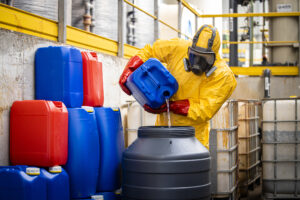In day-to-day life, many individuals encounter a plethora of harmful elements. From everyday household cleaners to pesticide residues on fruits and vegetables, and even contaminants in our water supply.
Yet, some professional sectors put employees at a higher risk of coming into direct contact with these toxic substances. This heightened exposure increases the likelihood of these workers developing severe health complications due to their occupational environment.
In certain situations, these affected individuals might be eligible to seek workers’ compensation due to their exposure at their place of work. Keep reading to learn more and contact PLBH at (800) 435-7542 to speak to an attorney experienced with toxic exposure workplace injuries.
Workplace Protection: An Ongoing Challenge
Regardless of the precautions one takes, from wearing specialized protective equipment to facial coverings, it remains an uphill battle to entirely negate exposure in specific industries. Think about agricultural endeavors where crops undergo pesticide treatments, mining sites engulfed in diesel emissions, construction roles, professions that involve welding or painting tasks, or roles in the aerospace domain.
Similarly, even seemingly innocuous industries, like the food sector, aren’t exempt from such risks. Consider, for instance, the artificial flavoring in microwave popcorn. It’s a popular snack, yet inhaling its aroma can pose health threats. Those working in facilities producing such items often face heightened exposure risks, potentially leading to occupation-related illnesses.
An Employer’s Duty to Inform and Protect
One would naturally expect employers to give clear indications about potential hazards, using warning labels, signage, or other informative means, especially for recognized threats like corrosive chemicals or radioactive substances.
However, what about less obvious hazards, such as the aforementioned popcorn flavoring? Or what about substances like everyday cleaning agents that may seem harmless in minimal quantities but can turn detrimental with consistent and prolonged exposure?
This is where the role of the Occupational Safety and Health Administration (OSHA) becomes paramount. Established to shield workers from potential workplace hazards, OSHA not only mandates businesses to enlighten and caution employees about recognized harmful substances but also stipulates permissible levels for airborne chemical exposure. If airborne chemicals surpass stipulated limits, either the workspace must be evacuated, or corrective actions must be instituted to restore safe breathing conditions.
Exposure to toxic chemicals can lead to a spectrum of severe health concerns, be it respiratory issues, cognitive disturbances, internal organ damage, or acute skin conditions. Such complications can manifest immediately post-exposure or could be the culmination of extended interaction with the harmful agent.
Should you find yourself compromised health-wise due to exposure to a detrimental chemical in your professional setting, you might qualify for workers’ compensation. At PLBH, our adept workers’ compensation lawyers are well-versed in securing deserving compensation for affected individuals, encompassing cases of hazardous chemical and substance exposure. To initiate a complimentary initial discussion and to better understand how we can serve you, reach out to PLBH at (800) 435-7542.

